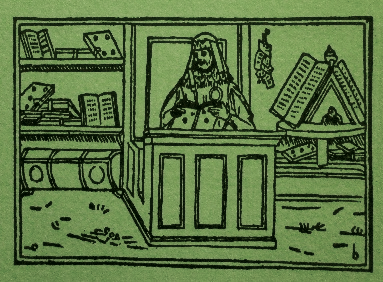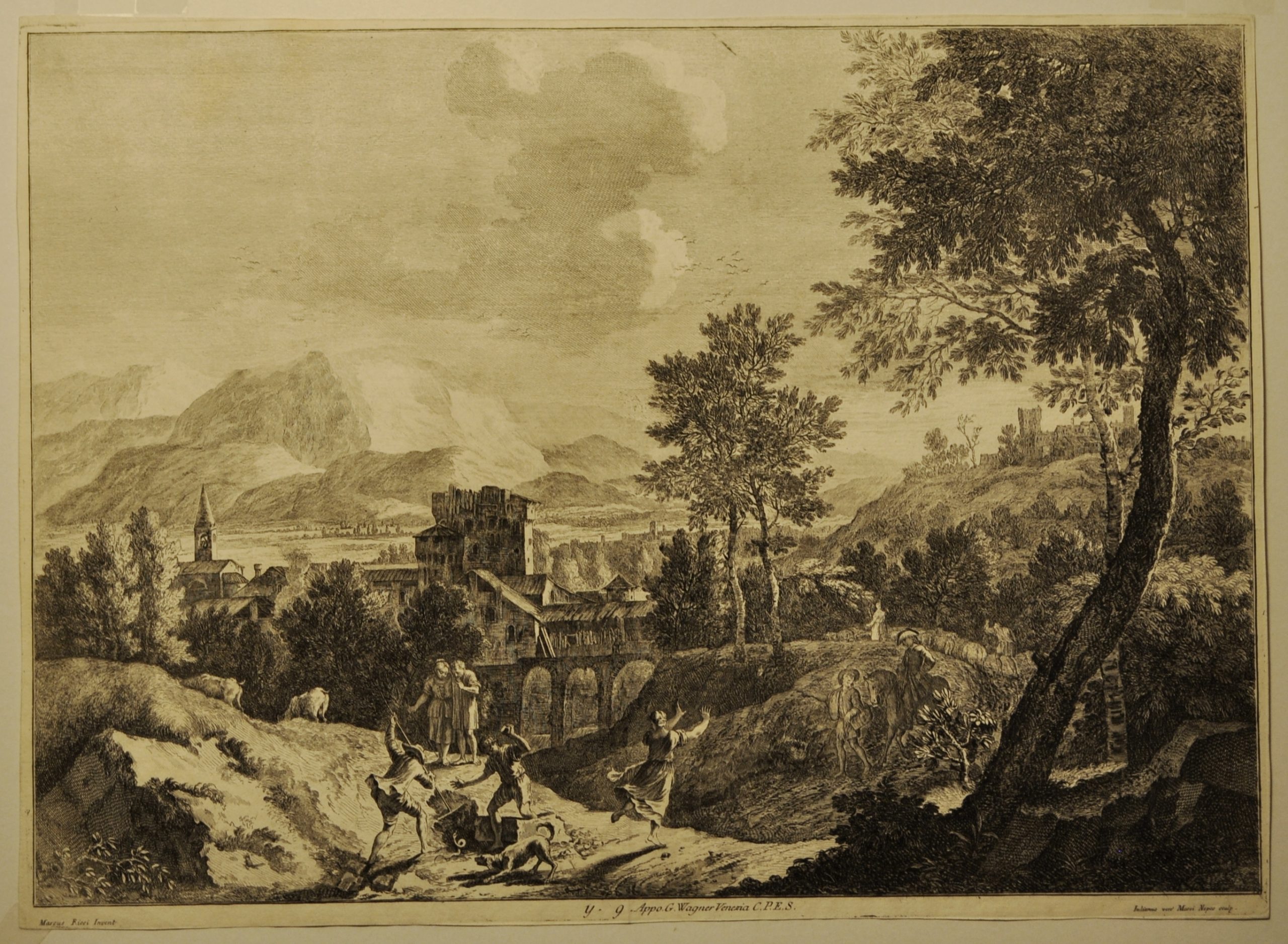Acquaforte e bulino di mm 310 x 426. Carta candida, spessa, fittamente vergata. Margini brevi. Filigrana “freccia con punta a cuore”. “Marcus Ricci invent” a sinistra, “Y 9 Appo G. Wagner Venezia C.P.E.S.” al centro, “Iulianus vero Marci Nepos sculp.” a destra. Margini molto ridotti all battuta. Provenienza: “Raccolta di 12 paesi inventate e dipinte dal Celebre Marco Ricci, poste in luce da G. Wagner in Merceria” Venezia s.d. (circa 1740). Secondo Alpago-Novello, questa serie di stampe incise da Giampiccoli da vedute dello zio Marco Ricci sono “tra le migliori delle veneziane del settecento”. In effetti la qualità tecnica ed artistica di questa serie raggiunge uno dei massimi livelli di raffinatezza tra le acqueforti settecentesche. Giuliano Giampiccoli nacque a Belluno il 3 Maggio 1703 da Gerolamo Giampiccoli e da Livia, sorella di Marco Ricci. Iniziò la professione nella città natale, per poi trasferirsi a Bassano nel 1730 per assumere la direzione del reparto di incisione in rame e in legno che era appena stato istituito dai tipografi e calcografi Remondini. Trasferitosi definitivamente a Venezia nel 1738, prese casa a S. Antonin; l’anno seguente, con l’arrivo di Giuseppe Wagner a Venezia, entrò, come altri grandi, a far parte di quel famoso laboratorio d’intaglio, perfezionando le proprie capacità tecniche, continuando tuttavia a mantenere rapporti professionali con i Remondini. Per conto del Wagner, appunto, il Giampiccoli eseguì le tredici incisioni, compreso il titolo, da dipinti dello zio, che andarono sotto il nome di “Raccolta di 12 paesi…” di cui il foglio qui presente è il nono. Incise poi una serie più grande in collaborazione con Bartolozzi, ed infine la grande serie di 48 stampe in collaborazione con Giambattista Tiepolo. Eseguì anche molti fogli sciolti, da quadri di Zocchi, Tiepolo, Piazzetta e Zuccarelli, ed illustrò alcuni libri, tra cui la “Divina Commedia” di Zatta del 1757-58., e la collezione delle commedie di Goldoni stampate da Pasquali tra il 1761 ed il 1777. Giuliano Giampiccoli morì a Venezia il 10 dicembre 1759, all’età di 56 anni. Di lui De Angelis (1809) scrisse “chi vedrà le stampe di questo artista, son persuaso che conoscerà ch’egli con molta facilità incise il paesaggio e la storia”. Riguardo agli stati della serie di cui fa parte questa acquaforte, Alpago-Novello sostiene esista una ristampa più tarda in cui vennero raschiate le “Y” e la numerazione araba, sostituendovi i numeri 51.1, 51.2 e così via, ma in un ordine diverso rispetto alla prima. Succi p.178, Pallucchini p. 49.Etching and burin 310 x 426 mm. Thick white, thickly laid paper. Short margins. Filigree “arrow with heart point”. “Marcus Ricci invent” on the left, “Y 9 Appo G. Wagner Venezia C.P.E.S.” in the center, “Iulianus true Marci Nepos sculp.” To the right. Very small margins at the beat. Provenance: “Collection of 12 villages invented and painted by the famous Marco Ricci, brought to light by G. Wagner in Merceria” Venezia s.d. (about 1740). According to Alpago-Novello, this series of prints engraved by Giampiccoli from views of his uncle Marco Ricci are “among the best of the Venetian eighteenth century”. In fact, the technical and artistic quality of this series reaches one of the highest levels of refinement among eighteenth-century etchings. Giuliano Giampiccoli was born in Belluno on May 3, 1703 from Gerolamo Giampiccoli and from Livia, sister of Marco Ricci. He began his profession in his hometown, and then moved to Bassano in 1730 to take over the direction of the copper and wood engraving department that had just been set up by the Remondini printers and chalcographers. Having moved permanently to Venice in 1738, he took up a house in S. Antonin; the following year, with the arrival of Giuseppe Wagner in Venice, he joined, like other greats, part of that famous carving workshop, perfecting his technical skills, while continuing to maintain professional relationships with the Remondini family. On behalf of Wagner, in fact, Giampiccoli made the thirteen engravings, including the title, from his uncle’s paintings, which went under the name of “Collection of 12 countries …” of which the present sheet is the ninth. He then engraved a larger series in collaboration with Bartolozzi, and finally the large series of 48 prints in collaboration with Giambattista Tiepolo. He also made many loose sheets, from paintings by Zocchi, Tiepolo, Piazzetta and Zuccarelli, and illustrated some books, including Zatta’s “Divine Comedy” of 1757-58., And the collection of Goldoni’s comedies printed by Pasquali between 1761. and 1777. Giuliano Giampiccoli died in Venice on 10 December 1759, at the age of 56. Of him De Angelis (1809) wrote “whoever sees the prints of this artist, I am convinced that he will know that he engraved landscape and history with great ease”. Regarding the states of the series this etching is part of, Alpago-Novello claims there is a later reprint in which the “Y” and the Arabic numbering were scraped, replacing the numbers 51.1, 51.2 and so on, but in a different order than to the first. Succi p. 178, Pallucchini p. 49.
Libreria Emiliana
Antiquaria
Libri e Stampe Veneziane
dal XV al XXI Secolo
dal XV al XXI Secolo


